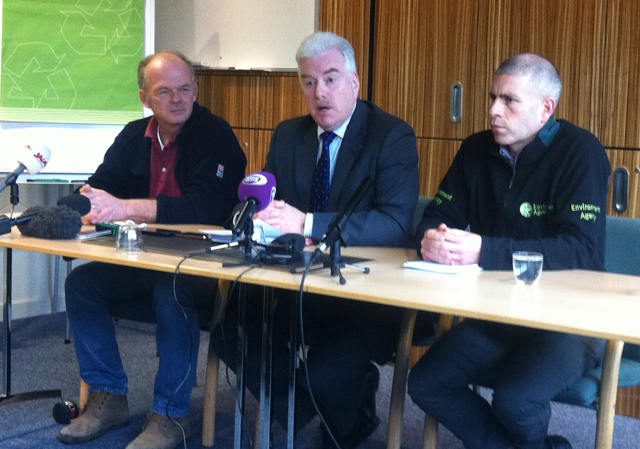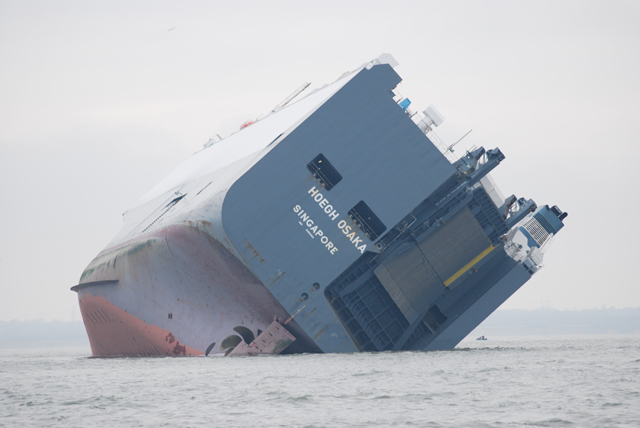The findings of an investigation into the listing, flooding and grounding of Hoegh Osaka on Bramble Bank in The Solent have been published.
At 2109 on 3 January 2015, the pure car and truck carrier Hoegh Osaka was rounding West Bramble buoy when it developed a significant starboard list causing some cargo shift and consequent flooding.

The Hoegh Osaka. Credit: Maritime and Coastguard Agency
A Marine Accident and Investigation Branch (MAIB) report summarises that with the list in excess of 40°, the ship lost steerage and propulsion, and subsequently drifted onto Bramble Bank, grounding at 2115.
Hoegh Osaka had sailed from the port of Southampton, bound for Bremerhaven, at 2006. A pilot was embarked and there were 24 crew on board. Following the accident, all crew were successfully evacuated from the ship or recovered from the surrounding waters.
There was no pollution. A major salvage operation successfully refloated Hoegh Osaka and it was subsequently taken to a safe berth in Southampton on 22 January.

Hoegh Osaka in port.
Stability modelling and analysis following the accident show that Hoegh Osaka heeled heavily to starboard while turning as a result of having departed port with inadequate stability.
Cargo distribution was such that the upper vehicle decks were full while the lower vehicle decks were lightly loaded. Hoegh Osaka was low on bunker fuel oil, which was stored low down in the ship. With no additional ballast having been loaded prior to departure, the ship’s overall centre of gravity was relatively high. The analysis also concluded that it was most likely that the cargo shifted due to the ship’s excessive list and was not causal to the accident.
Hoegh Osaka’s itinerary had changed from its routine loading rotation between three north-west European ports. The actual cargo weight and stowage were significantly different from the final cargo tally supplied to the ship. Ballast tank quantities were estimated on board and differed significantly from actual tank levels.
Cargo unit vertical centres of gravity were routinely not allowed for in the ship’s calculated stability condition. These factors all combined to result in the ship leaving Southampton with insufficient stability for the voyage.

The Hoegh Osaka. Credit: Maritime and Coastguard Agency
A key finding of the MAIB investigation is that no departure stability calculation had been carried out on completion of cargo operations and before Hoegh Osaka sailed.
Witness and anecdotal evidence suggests that this practice extends to the car carrier sector in general. The fundamental requirements for establishing before departure that a ship has a suitable margin of stability for the intended voyage had been eroded on board Hoegh Osaka such that unsafe practices had become the norm.
The owner and manager of Hoegh Osaka have taken a number of actions aimed at preventing a recurrence, and the MAIB has made recommendations to both to further enhance their respective instructions and procedures.
Read the full report at www.maib.gov.uk
Höegh Osaka: successfully alongside in port
The cargo ship Höegh Osaka is now safe alongside in the Port of Southampton.
Hoegh Osaka – pumped out and readying to move
Salvors preparing to move the stricken Höegh Osaka cargo ship out of the Solent waters have finished pumping water off…
Air exclusion zone for stricken Höegh Osaka ship
Salvors will be using a commercial helicopter rather than sea transport to access the Höegh Osaka cargo ship during rough…
Höegh Osaka ‘stable’ despite high winds
The stricken cargo ship Höegh Osaka is currently 'stable' in its new location near Spitbank, in the eastern Solent.
Höegh Osaka on the move
The stricken Höegh Osaka cargo ship is being towed to a new location after self-floating at high water in the…
‘No quick fix’ for operation to refloat Höegh Osaka cargo ship
The stricken Höegh Osaka was 'deliberately grounded' in the Solent, a press conference was told.
Car carrier Hoegh Osaka aground on Bramble Bank
Photos from Sunday 4th January of the car carrier Hoegh Osaka which ran aground on the tail of the Bramble…
Container ship ‘deliberately grounded’ on Bramble Bank in the Solent
The container ship APL Vanda was deliberately run aground on West Bramble Bank in the Solent following 'a loss of…
Crew rescued from sticken cargo ship
The car carrier remains grounded on the Bramble Bank, listing at 45 degrees, but out of the shipping channel












